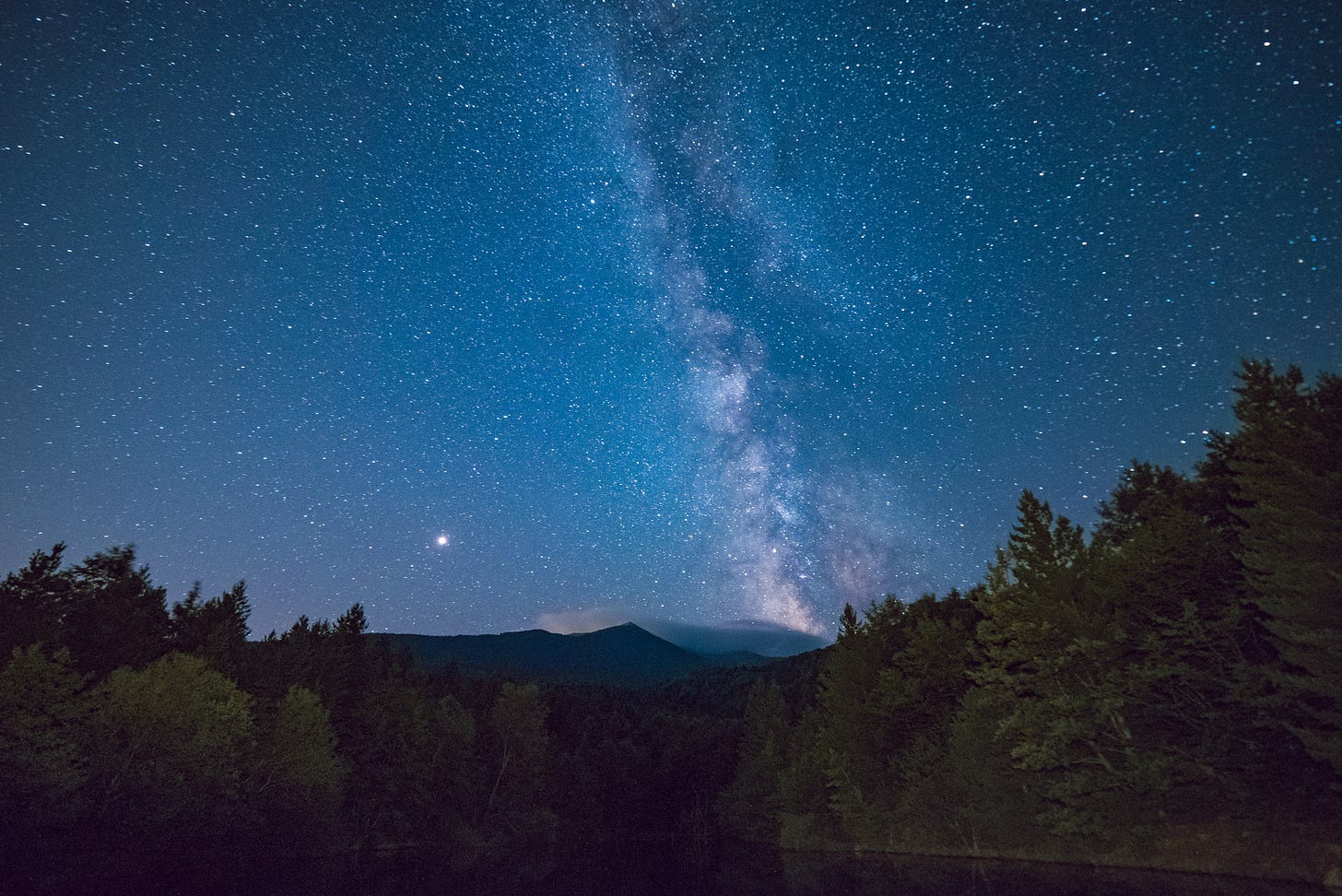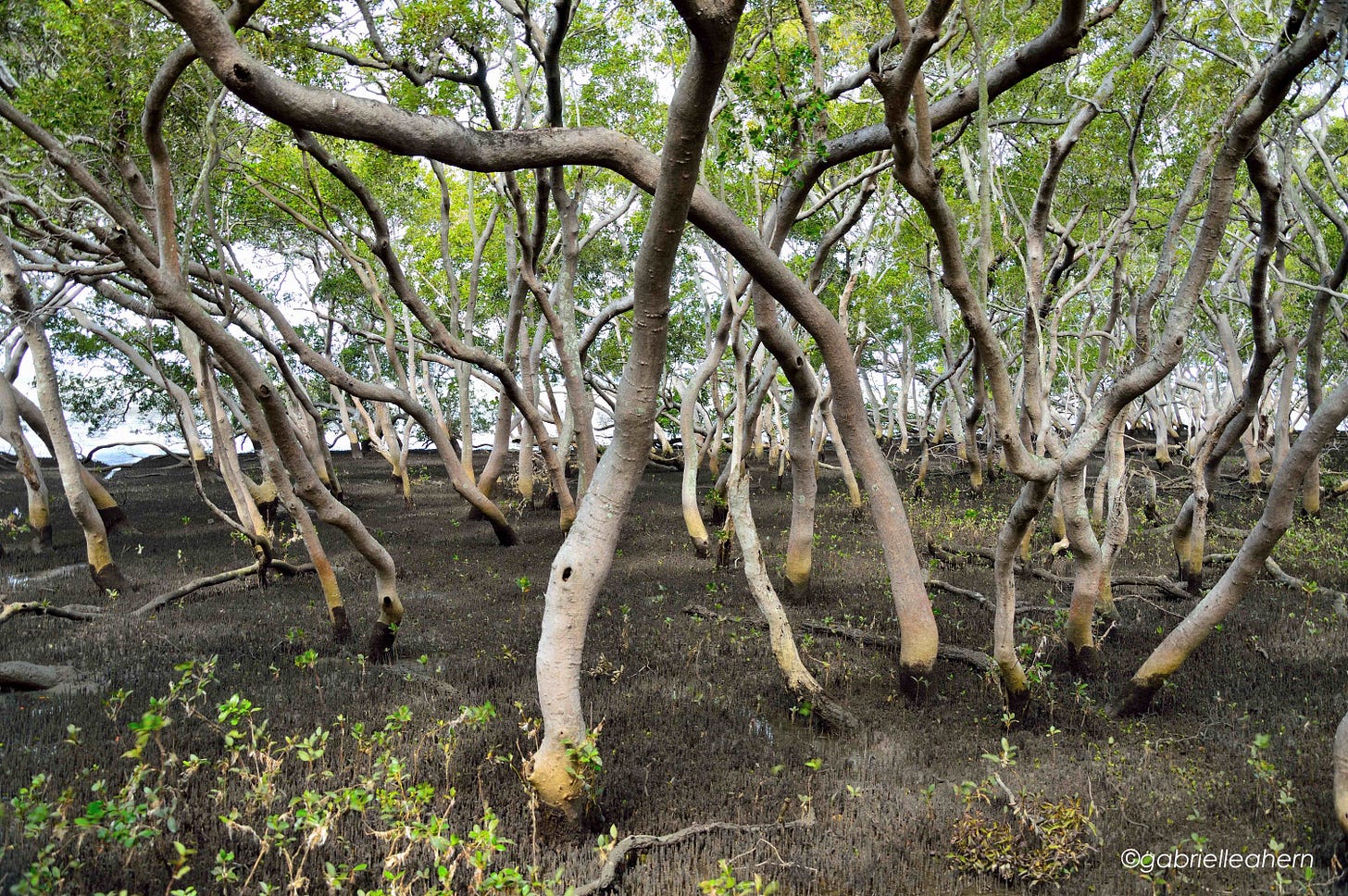Welcome to the Salty Wave® Newsletter (December 2023) a place where curious digital travelers can discover the weird and wonderful of science, follow my strange sidetracks into nature, listen to soundscapes, and learn a bit of scientific knowledge and lab talk. I specialize in producing videos for scientists, labs, institutes, museums, and universities through Research Journey Narratives. This is the last newsletter for 2023 and there is something for everyone to read, view or listen to.
This December
· Soundscape Adventure for the Senses
· Strange Sidetrack into Mangroves
· Not Every Yellow Brick Road is the Same
. Video Project Update
· I Dig This
Image by Baurzhan Kadylzhanov
Soundscape Adventure into the Senses
Sound is studied and objectified through creative interpretation in music, film and theatre, and deconstructed by scientists who research why sound waves existed in the first place, how sound waves travel and when life on Earth evolved the capacity to hear those sounds.
Across the planet you can journey through soundscapes that are all dissimilar to one another. But what connects them is the type of sound produced. In all those soundscapes, the sound waves are mechanical because sounds travel through a medium such as the molecules in water, air or solids; as opposed to space, where there is virtual silence because there is no matter for sound waves to travel through.
Image by Hristo Fidanov
Sound waves can be described as being like a vibration that moves from one molecule to the next, in a process that’s a bit like a Mexican wave. Sounds are produced in other parts of the solar system, on planets and moons. NASA recently recorded the sound produced by an enormous cloud of gas. Its particles provided the media for sound waves to move through in that part of space.
Space is observed from Earth using powerful telescopes that detect light. NASA scientists have interpreted this data which is invisible to the naked eye into a composition of musical notes so people can observe space by listening to the harmony of songs created. You can learn more about the study here.
If you have listened to audio recordings of forests or underwater locations like coral reefs, you’ll discover patterns in the sounds which reflect the diversity of species inhabiting or migrating through those areas at certain times of the day or night, in addition to the physical sounds that might be produced during earthquakes, trees falling or waves crashing onto beaches for instance. Something noteworthy about soundscapes are the noises related to traffic, construction, conversations and machines - the general noise and mayhem of everyday human activity - that impact on the environment and the wildlife inhabiting it.
I’ve found a selection of soundscapes recorded in forests and coral reefs. It’s an interesting exercise to listen to places that are unfamiliar territory - the contrasting silences stand out to me because despite the silence there might be animals moving around, sleeping or eating. In a wild landscape, you expect to hear what you see, but in many cases, that is not the case. In a previous story I mentioned cryptic animals are difficult to spot because their feathers, fur or scales are well camouflaged - match their habitat perfectly - making it difficult for even the most experienced ecologist to locate them during field surveys. Interestingly, the conversion of audio recordings into visual spectrograms has simplified the task of analysing a habitat for different research purposes, for example, to assess population biodiversity, anthropological impacts or the environmental health of a specific area. These soundscapes are quite foreign to listen to, but when immersed in that experience, it can be compared to a holiday for the senses.
In a report published by Scientific Reports in 2017, a research team found listening to natural sounds had therapeutic benefits to listeners. Another paper published by the same Journal in 2021, reported images of natural landscapes improved cognitive function and reduced stress in participants. The researchers also noted that humans have evolved in natural environments over time and perhaps this artefact from our evolutionary past is embedded into the bones of our human memory. My interpretation is this ancestral condition continues to impact on human brain function and how it perceives its surroundings. This makes sense when you consider humans have survived by their wits and intuition and continue to live in dynamic environments that are controlled by nature.
Sound therapy has been practiced for thousands of years. NASA have reported sounds played at a frequency help the body to heal and scientists have developed an application called The Evolutioner. It is based on ancient therapies that some cultures use to raise the “vibrational pitch” of the body. People listen to 12 minutes of audio that pulses a “square waveform sound wave at a frequency of 10Hz.” The inventors of the sound platform state the frequency stimulates stem cell activity, which promotes the health of DNA and increases cell growth, contributing to the body’s ability to heal and reduce the effects of aging.
I think conservation of, and creation of green spaces, don’t just provide corridors for wildlife to inhabit and migrate through, they also give the human mind freedom to wander and learn by being curious.
Strange Sidetrack into a mangrove forest
Speaking of nature walks, if you are looking for somewhere different to stroll, then a visit to your local mangrove forest is something you should consider.
Mangrove trees have adapted to the harshness of the marine environment and their incredible morphologies reflect the dynamics of living on the edge of the ocean, exposed to the sun, coastal sea breezes, anthropological changes, moving tides, storms, cyclones and floods.
Fresh water is in short supply and mangroves, like all plants, need fresh water to grow and reproduce. Mangroves thrive in fresh or salty water but grow best in a combination of 50 per cent fresh water and 50 per cent salt water. Sometimes the water can be too salty, making conditions inside the cell toxic and difficult to retain water, which unfortunately leads to dieback. In 2016, 40 million mangrove trees died along 2000 km of coastline in the Gulf of Carpentaria located in northern Australia. Scientists reported the anthropological impacts plus lack of rainfall and drop in sea level had contributed to the event, described as the worst climate related mass tree death ever recorded in the world, releasing 1 million tons of carbon into the environment.
Without pressures from human activity, mangroves have a chance to survive climate change with the help of a few evolutionary tricks in their genetic traits. These trees have developed physical adaptations to cope with salt stress, through a mechanism known as salt exclusion described below.
Leaves: mangrove species have thick cuticles, sunken stomata and salt glands which work together to regulate salt levels and reduce dehydration from water being lost though the leaves. To help store freshwater in their leaf tissues, salt glands extract excess salt from the sea water and expel it through the outer layer of the leaf (the epidermis). The salt on the surface of the leaves tastes as you would expect - salty. Another strategy mangroves have developed is increasing the surface area and thickness of leaves to protect the process of photosynthesis. (Photosynthetic activity is also reported to induce salt tolerance in plants.)
Roots: mangroves have developed roots that extrude salt through the xylem vessel walls which transport water from the roots. Mangroves possess different types of roots: pneumatophores, cable or prop roots.
There are other ways mangroves have developed to survive and the fact these forests can tolerate such inhospitable conditions is a remarkable feat of nature, and a topic I’ll be exploring more in future stories.
Here is a report with a scientific description of salt exclusion observed in other plant species.
Not every yellow brick road is the same.
Following the yellow brick road with Dorothy and Toto in the Wizard of OZ in 1939 was a groundbreaking event in film making because of the film colour process – Technicolour. The film starts in black and white on an American farm and when a freak tornado hits Kansas, Dorothy and her little dog Toto, wake up in the Land of Oz – a colourful fantastical place of wonder where the heroine’s adventure begins. Apart from the technical mastery achieved in the movie making process, colour is not perceived the same way by all human beings or indeed in the animal and plant kingdoms. It all depends on how you are geared. In this story, I talk about colour, and the considered approaches that should be followed, to make content accessible for everyone.
Experiencing the world and everything we encounter is specific to our lifestyle, language, culture and where we live, we all have a different perspective to what’s happening in our community. The same can be said of going to the movies or watching television programs. Entertainment in all its forms, reflects the times and the fashions of the day. Colour film was developed in the 1900s and Technicolor was the first successful colour film process introduced to film making in 1915. Memorable movies like Gone with the Wind and The Wizard of Oz were created using Technicolor – where a three colour separation process was applied to enhance the vividness of the colours, making the scenes appear closer to real life. Ever since then, colour has been an integral element of film, television and photography production.
Image by Giovanni Calia
Presenting a story in colour creates an immersive experience for viewers and heightens the video presentation’s entertainment value – enabling visual storytellers to evoke emotions or convey atmosphere to support the narrative. Large sized television screens being sold in stores often screen beautiful colourful scenes of nature or city backdrops in attractive high-resolution videos to lure the customers attention. In a study by the American Psychological Association, colour videos were reported as more memorable as opposed to stories presented in black and white. The study’s results showed individuals who viewed colour videos were able to recall approximately 65 per cent of information, compared to 25 per cent accuracy when remembering information by watching black and white videos. But is experiencing colour a common sensation for everyone?
1 in 12 men (8%) and 1 in 200 women (0.5%) are colour blind, with a total of 300 million people experiencing colour blindness worldwide, according to the World Health Organization (WHO)). Colour blindness affects an individual’s ability to detect different colours and individuals see colour but in a different way. For instance, when someone is red-green colour blind, they see the colours red and green in tones of grey and brown. Colour blindness is also common in primates, dogs and cats – many nocturnal animals are colour blind. Nocturnal animals depend more on their sense of smell or hearing to hunt for food or evade predators at night.
Owls for instance, do not perceive colour in the same way as humans. These birds have 4 types of colour receptors, so colours are not as vivid to owls as they might appear to most human eyes, which possess 3 colour receptors. But owls are nocturnal creatures geared to see in low light conditions and the high concentration of light sensitive cells in their eyes enables them to collect as much light as possible, giving them excellent night vision.
Colour is an important feature of the natural world and contributes to the biodiversity of species in the animal and plant kingdoms. Aposematism is where animals express bright colours to warn predators they are venomous or poisonous. Monarch butterflies have black and orange wings but are toxic when consumed by predators. Poison dart frogs from Central and South America are colourful looking frogs but the toxin secreted from their skin is known to cause paralysis or death. Different animal species avoid predation by camouflage – changing their colour to blend with their natural surroundings, for example, the chameleon is named for its ability to adopt the colour of its environment; leaf insects are green and shaped like a leaf; while the white fur of the arctic fox helps it hide in the snowy landscape to find prey and avoid predators.
Colour is also used to attract mates during courtship by many animal species, for instance, male peacocks show off their brightly coloured plumage to charm a female; and male betta fish flash their colourful fins to entice a female. For some animals, colour is not the most advantageous trait to have, especially females. It is important for female birds like finches, robins and sparrows to have dull plumage compared to their male counterparts because the females need to stay on the nest to rear and protect their young. Having dull feathers enables the birds to blend into their surroundings, brightly coloured plumage would attract predators. There are many plant species that exhibit bright colours to show toxicity. Foxglove is extremely toxic and has pink or purple bell-shaped flowers, if swallowed Foxglove can cause heart problems. The pretty pink and white Oleander flowers can be fatal if consumed.
All living things approach life from a different perspective and however the way we are wired to perceive the environment, shapes patterns of behaviour, thoughts, and actions; and science research highlights the importance of considering how people access information.
A few approaches for using colour to present information I always follow are the following:
Guaranteeing the contrasting colours support the brand but are also selected so text and visuals can be seen and appreciated clearly by all viewers;
Make sure that the visuals are interesting by researching the story thoroughly and also, to compliment the mood of the story or the emotions being conveyed, so that’s where I might use black and white for historical narratives or to indicate an emotion;
For the presentation of text, I use colours that enable audiences to read the information legibly because to some people certain colours may not be visible due to colour blindness;
Use colour only as a background for text in some videos, so audiences can absorb the information without distraction from moving visuals.
Being aware of and appreciating that not all humans observe colours in the same way, just as in nature, should be one of the considered approaches to producing content that everyone can engage with, be entertained by, learn from and respond to.
Originally published 8 December 2023
Video Project Update
If you haven’t watched my new video series: Planet in Focus, now is as good a time as any. Here is the link:
I’m planning to produce more videos in the ocean series and other environments like forests. So stay tuned!
I Dig This
Hi Pals, I’m having a furry great time. I wish you a Merry Christmas and Happy New Year with lots of treats and fun sniffari adventures in 2024! Luv Rocky!
[Don’t pawget, if you want to share your shenanigans about treatos, stuffed frens or sniffaris here, I’m contaktibel through my hooman. You can find my floofy tail on Instagram, Facebook, Mastodon & Twitter 💙 Rocket @saltywavedog🐶]
End Point
We’ve reached the endpoint of the Newsletter and I hope you enjoyed learning more about the curiosities of science with Salty Wave Stories in 2023! Next month, I’ll feature more interesting tales, updates about my video projects, and a post by Rocky. Thank you for following my stories! I wish everyone a Merry Christmas and hope 2024 brings more happiness, peace and freedom for everyone worldwide! See you next year!
Gabrielle Ahern, Founder / Visual Storyteller, Salty Wave® saltywave.com.au
If you know someone who might be interested in my Newsletter, please share the link.








